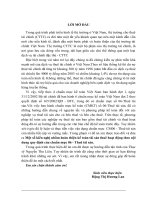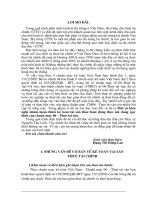06 trade remedies
Bạn đang xem bản rút gọn của tài liệu. Xem và tải ngay bản đầy đủ của tài liệu tại đây (146.72 KB, 26 trang )
SOUTH EAST ASIA
TRADE POLICY
TRAINING NETWORK
SEATRANET ADVANCED COURSE
NON AGRICULTURAL MARKET ACCESS (NAMA)
Module 7:)
Safeguards and Other Forms
of Contingency Protection
1
SOUTH EAST ASIA
TRADE POLICY
TRAINING NETWORK
OUTLINE
This Module covers 3 types of
Contingency Protection
1.Safeguards
2.Anti-dumping
3.Subsidy Countervail
2
SOUTH EAST ASIA
TRADE POLICY
TRAINING NETWORK
1. Safeguards
3
SOUTH EAST ASIA
TRADE POLICY
TRAINING NETWORK
Safeguard Measures
Safeguard measures are emergency actions
with respect to increased imports of
particular products, where such imports have
caused or threaten to cause serious injury to
the importing members’ industry.
4
SOUTH EAST ASIA
TRADE POLICY
TRAINING NETWORK
Safeguard Measures
• Different from other forms of contingency
protection in that safeguards are actions
taken against fair trade.
• The WTO Agreement on Safeguards is
provided for in Article XIX of GATT 1994.
5
SOUTH EAST ASIA
TRADE POLICY
TRAINING NETWORK
Safeguard Measures
• The guiding principles of the Safeguard
Agreement include:
– Measures must be temporary, normally for
four years, but can be extended.
– They can be imposed when imports are found
to cause or threaten serious injury to a
competing domestic industry.
6
SOUTH EAST ASIA
TRADE POLICY
TRAINING NETWORK
Safeguard Measures
• Serious injury is a strong test requiring “a
significant overall impairment in the
portion of the domestic industry.”
• Domestic industry is the group of
producers as a whole of the like or directly
competing product, operating within the
territory or producers who collectively
account for major proportions of the
domestic production.
7
SOUTH EAST ASIA
TRADE POLICY
TRAINING NETWORK
Safeguard Measures
• Safeguard Measures are applied on an
MFN basis
–
–
They must be progressively liberalized.
The country taking an action must pay
compensation to members whose trade is
affected.
8
SOUTH EAST ASIA
TRADE POLICY
TRAINING NETWORK
Safeguard Measures
• The requirement of increased imports can
be met by an absolute or relative increase.
• The measure is to be applied only to the
extent required to remedy or prevent the
injury and to facilitate adjustment.
9
SOUTH EAST ASIA
TRADE POLICY
TRAINING NETWORK
Safeguard Measures
• Safeguard Actions can include:
– an increase in the applicable tariff or
– a quota
• While the agreement does not deal with how a
tariff should be set, it does provide guidance on
the development and allocation of quotas.
• If the Parties cannot agree on the appropriate
compensation, the aggrieved party may retaliate.
10
SOUTH EAST ASIA
TRADE POLICY
TRAINING NETWORK
Safeguard Measures
• Developing countries will not be included in a
safeguard action where the import share from a
single developing country is less than 3%,
provided that developing countries below this
threshold do not collectively account for more
than 9% of imports.
• The Agreement provides clear guidance of the
required transparency for taking actions and on
the administrative steps required.
11
SOUTH EAST ASIA
TRADE POLICY
TRAINING NETWORK
Rationale For Safeguard
Measures
• The potential to use Safeguards is particularly
important at times when tariffs are being
reduced.
– Safeguards provide some comfort to the public and
to producers that there is an appropriate mechanism
available if tariff reduction leads to a surge in
imports with the potential to cause serious injury.
12
SOUTH EAST ASIA
TRADE POLICY
TRAINING NETWORK
Safeguards in
Preferential Agreements
• Most preferential arrangements (whether
unilateral or negotiated agreements)
contain a safeguard mechanism.
– Safeguard mechanisms are particularly
important in FTAs since substantially all
tariffs are eliminated.
13
SOUTH EAST ASIA
TRADE POLICY
TRAINING NETWORK
Safeguard Measures in
FTAs
• In a FTA, a safeguard mechanism is
usually in place for a fixed time period in
response to the actual reduction or
elimination of the tariff.
• The various principles of the WTO
agreement can be adjusted for a FTA.
14
SOUTH EAST ASIA
TRADE POLICY
TRAINING NETWORK
Safeguard Measures in
FTAs
• There is clear potential for adjusting the
principles in an asymmetric fashion if the
FTA involves countries at different stages
of development.
– A safeguard mechanism is of significant
benefit to FTA negotiations as it produces a
“safety net” in case negotiated tariff
elimination leads to injury and can be used to
help reduce public concerns.
15
SOUTH EAST ASIA
TRADE POLICY
TRAINING NETWORK
2. Anti Dumping
16
SOUTH EAST ASIA
TRADE POLICY
TRAINING NETWORK
Dumping
• Dumping is defined as selling a good at
less than its normal value.
- Usually the price in the home market or the
cost of production
• Dumping is an action of the company
involved and therefore outside the direct
control control of government.
17
SOUTH EAST ASIA
TRADE POLICY
TRAINING NETWORK
Dumping
• If an industry makes a dumping complaint,
an investigation is required to prove
dumping and its value
• If dumped sales cause material injury to
domestic interests, then dumping duties can
be applied equal to amount of dumping
margin
18
SOUTH EAST ASIA
TRADE POLICY
TRAINING NETWORK
Material Injury
• To enforce a “dumping duty”, it must
be shown that material injury has
occurred.
• Injury can take many forms:
–
–
–
–
Lost sales
Lost profits
Reduced employment
Unused factory capacity
19
SOUTH EAST ASIA
TRADE POLICY
TRAINING NETWORK
Dumping
• Injury must be found to be material
• No definition but left to each country to
set limit.
• Dumping duties remain in effect as long as
the action is taking place.
• Countries can enter into a price
undertaking (not to dump) and have duties
waived.
20
SOUTH EAST ASIA
TRADE POLICY
TRAINING NETWORK
Dumping
• The Anti-Dumping Agreement emerged
from the Uruguay Round.
• Very controversial, seen by many as
effective barrier to trade.
• Re-negotiation included in Doha Round,
but with very restrictive mandate.
21
SOUTH EAST ASIA
TRADE POLICY
TRAINING NETWORK
3. Subsidy Countervail
22
SOUTH EAST ASIA
TRADE POLICY
TRAINING NETWORK
Subsidy Countervail
• Governments sometimes provide monetary
support (subsidy) to their producers.
• UR created first subsidy definition.
• Support given only when products are
exported or to replace imports is
prohibited in WTO.
– If proven to exist thee subsidies must be eliminated.
23
SOUTH EAST ASIA
TRADE POLICY
TRAINING NETWORK
Subsidy Countervail
• Under the WTO dispute process an
investigation is carried out to determine
existence of subsidy and level of support
it provides to producers.
• Another investigation is then undertaken
to determine if there is material injury to
domestic producers in the importing
country.
24
SOUTH EAST ASIA
TRADE POLICY
TRAINING NETWORK
Subsidy Countervail
• If material injury exists, then a
“countervail duty” may be imposed to
match the subsidy.
• Stays in effect as long as the subsidy
continues.
25









